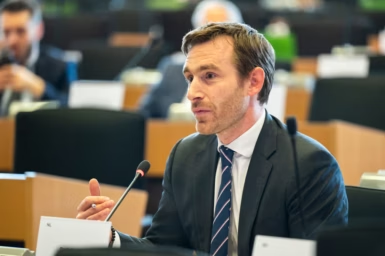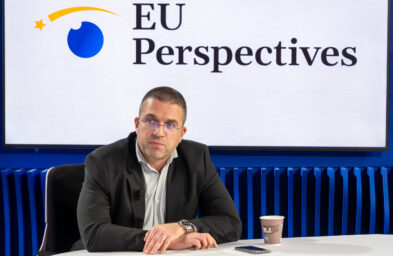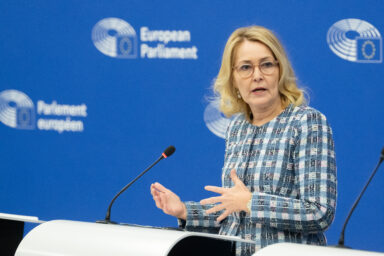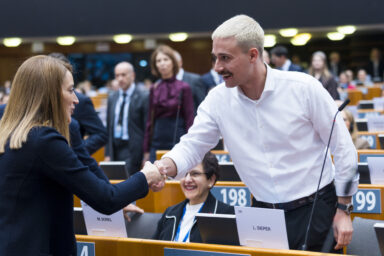The ReArm Europe initiative aims to significantly boost European defense capabilities by 2030. According to MEP Lucia Yar (Renew/SVK), the goal is not simply to spend more, but to spend more efficiently. Yet, she warns, the need to act quickly cannot come at the expense of transparency.
Yar is the rapporteur for the Budgetary Committee’s opinion on the European Parliament’s stance regarding the strategy. “The most important thing is that we need to change the old mindset of politicians and focus strongly on production within the EU,” she says in an interview with EU Perspectives
In the draft opinion, it is stated that the EU’s defense readiness is still insufficient. What main priorities would you like to push in further negotiations to ensure that investments in defense actually translate into higher readiness by 2030?
Our priority must be linking European planning and budgets – today we have 27 national defense strategies but no common European capacity map. We need to focus resources on areas where there are gaps. I see these not only in automated defense systems, air defense, and cybersecurity, but also in cognitive security. We must work to ensure that Europeans can protect themselves from hoaxes and disinformation from Russia or other hostile countries.
Today we spend a lot, but in an uncoordinated way; the goal is therefore to spend more efficiently. EU defense must be built on common plans, well-developed capacities, and good coordination. In the current situation, symbolic commitments are no longer enough.
Skipping oversight risks suspicions and inefficiency
The text criticizes the use of Article 122 TFEU to create new defense tools without involving Parliament. From the perspective of the Budget Committee – how do you think democratic and financial oversight of such mechanisms should be strengthened without limiting flexibility in crisis situations?
Quick responses in crises are exactly what defense is about, but we cannot bypass democratic control. When investing in defense, we are talking about billions of euros, which most states borrow and will repay over decades under favorable conditions. Since this is about strategic planning for the next decades, the process must be done not only collectively but also transparently. If we skip oversight of how funds are allocated under the argument that we must act quickly, we risk people and companies thinking the same as with vaccine procurement. At worst, suspicions could arise that contracts are awarded to friends of influential EU figures, or people might doubt whether we are really spending money on the equipment and systems our defense truly needs.
Flexibility must be linked with trust, and trust arises only through democratic oversight. Parliament should have access to detailed budget data and impact assessments. This preserves both decision-making speed and citizens’ confidence that the money will not end up with politicians’ friends.
You might be interested
As rapporteur for the Parliament’s budgetary committee, you also look at defense through the lens of spending efficiency and budgetary responsibility. How can the balance be found between the need to increase defense investments and the necessity of maintaining fiscal discipline in member states and the EU budget?
European investment in defense should be a collective saving, not collective debt. We should strengthen joint procurement within EDIRPA and link it to the European budget through multiannual planning. This would reduce duplication and create pressure on the efficiency of national budgets. At the same time, we must protect budgets for education and innovation – because without them, there will be no one to manage defense.
Supporting EU-Made defense capabilities
The proposal emphasizes the need to develop the European defense industry and reduce import dependence. Which financial or budgetary instruments do you think could best support innovation and production within the European Defense Technological and Industrial Base (EDTIB)?
In Defence Readiness 2030, we talk about expanding the mandate of the European Investment Bank (EIB). I am in contact with the EIB Vice President responsible for defense. They are reporting good initial experiences. Additionally, the expansion of the Defense Equity Facility is being considered as a tool for private investors. The original plan envisages an investment of around €175 million, but in negotiations, we are pushing for this amount to be more than five times higher. It is a process and a change of mindset in the EU so that our money can be invested in something collective, such as drone production.
A major weakness of the EU is that the vast majority of military systems are imported from non-EU countries. We should simplify processes for domestic companies. For example, in Slovakia, large corporations operate, but there are also many small and medium-sized enterprises. I have visited several of them. They develop excellent products and capabilities that can supply not only the Slovak army but also European and allied forces.
However, the licensing process for full-scale production, sale, and subsequent export is lengthy. This is a concern for companies. It happens at the national level, and Slovakia is no exception. Our authorities “ping-pong” applications back and forth; requests come from different sides, and the process drags on. Changes should also come through the “defense omnibus,” where I am the main rapporteur in the European Parliament.
The Defence Omnibus will likely not be the only program simplifying defense legislation. The faster we go, the more countries, armies, and the defense sector in individual countries realize what can and should be improved. The most important thing is that we need to change the old mindset of politicians and focus strongly on production within the EU. Yes, there are huge gaps in the supply of basic materials, but we can gradually fill them.
The report notes that ESG and financial rules often automatically exclude defense projects. What adjustments to these rules would you support so that the defense sector can access investment without straying from European values and sustainability principles?
We need to stop seeing defense as the opposite of sustainability. I am convinced it can be set up so that we do not have to make major compromises in climate protection. Yes, some chemical industry legislation will need to adapt to defense needs.
I cannot yet say how strong the pressures from one side or the other will be, because we are at the beginning. But I have already attended several negotiations and hearings where options were explained so that solutions can be found.
For example, it would make sense to have clear criteria for responsible investments in defense – i.e., that defense projects can meet ESG standards if they contribute to civilian protection, cybersecurity, or the energy efficiency of armies. If the EIB allowed financing of such projects, it would open space for new technologies, including green logistics, low-carbon materials, or smart sensors. Defense in the 21st century is no longer about tanks but about technology and resilience.
One dashboard to track projects and funding?
The Parliament warns against fragmentation of national projects and duplication of expenditures. How can the EU ensure that new initiatives – such as ReArm EU or EDIRPA – truly complement national budgets and do not lead to unnecessary overlaps?
The European Union has only a limited set of tools it can influence. It can provide instruments, finance training for people at contact points handling permits for our defense companies. But it has no competence in national administrations or ministries. And certainly not in armies. The basis for answering your question is common planning. ReArm EU and EDIRPA must be connected through a single coordination framework, and partly, these mechanisms rely on sharing information about member states’ needs.
As a former journalist, I like tools where I can find all the information in one place. Ideally, we could have a defense investment dashboard showing where projects are, who finances them, and what their benefits are. This could prevent three different funds from supporting the same system in three countries.











